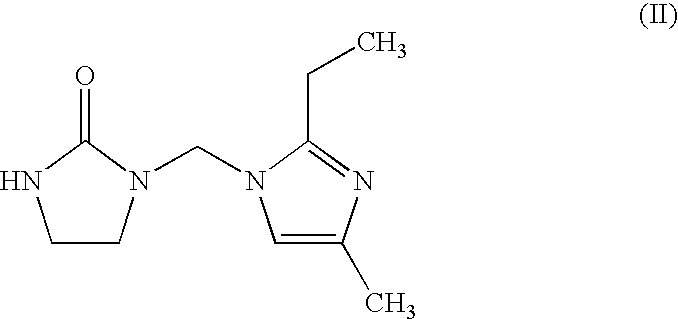Epoxy resin with dibasic acid (methyl ester)/ethyleneurea modifier
a technology of methyl ester and epoxy resin, which is applied in the field of acylethyleneurea terminated compounds, can solve the problems of high concentration of blocking agent, and achieve the effects of reducing latency, increasing viscosity, and improving epoxy-hardener system latency
- Summary
- Abstract
- Description
- Claims
- Application Information
AI Technical Summary
Benefits of technology
Problems solved by technology
Method used
Image
Examples
examples
[0037]1) 2 phr EU / EMI, baseline[0038]7 days latency (2× viscosity increase)[0039]6 hr. cure @80 degrees C.[0040]2) 6 phr isophthaloylbis(ethyleneurea), dissolved in the epoxy by briefly heating to about 100 degrees C.[0041]2 phr EU / EMI, dissolved with gentle heating.[0042]8 days latency (2× viscosity increase).[0043]4 hr. cure @ 80 degrees C.[0044]3) 6 phr isophthaloylbis(ethyleneurea), pre-reacted with the epoxy at 120 degrees C., 1 hour.[0045]2 phr EU / EMI[0046]The cure time at 80 degrees C. was 3 hr.[0047]Latency was 6 days (2× viscosity increase).[0048]4) 6 phr isophthaloylbis(ethyleneurea), pre-reacted with the epoxy resin at 120 degrees C., 1 hr.
[0049]The modified epoxy was an extremely viscous, semi-solid at ambient temperature but the viscosity at 120 degrees C. was very low.[0050]6 phr isophthaloylbis(ethyleneurea), dissolved in the modified epoxy at about 80 degrees C.[0051]2 phr EU / EMI, dissolved with gentle heating.[0052]This mixture was a highly viscous semi-solid at amb...
PUM
| Property | Measurement | Unit |
|---|---|---|
| temperature | aaaaa | aaaaa |
| cure temperature | aaaaa | aaaaa |
| concentration | aaaaa | aaaaa |
Abstract
Description
Claims
Application Information
 Login to View More
Login to View More - R&D
- Intellectual Property
- Life Sciences
- Materials
- Tech Scout
- Unparalleled Data Quality
- Higher Quality Content
- 60% Fewer Hallucinations
Browse by: Latest US Patents, China's latest patents, Technical Efficacy Thesaurus, Application Domain, Technology Topic, Popular Technical Reports.
© 2025 PatSnap. All rights reserved.Legal|Privacy policy|Modern Slavery Act Transparency Statement|Sitemap|About US| Contact US: help@patsnap.com



